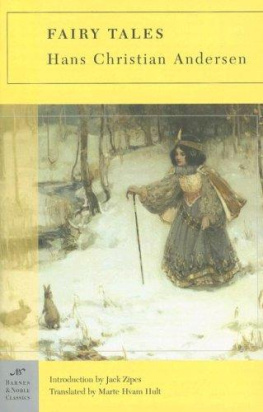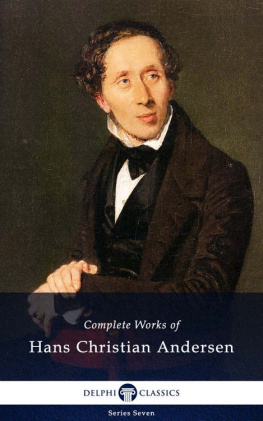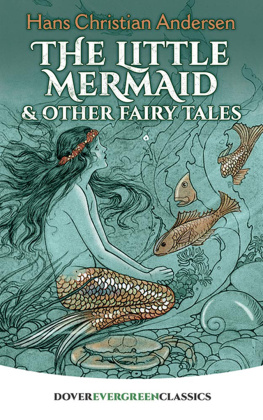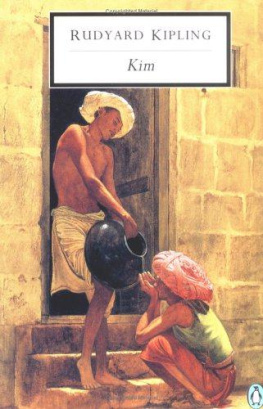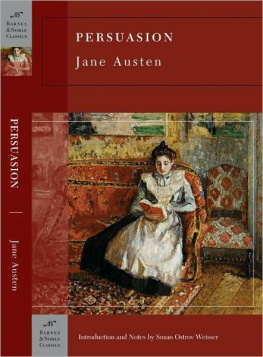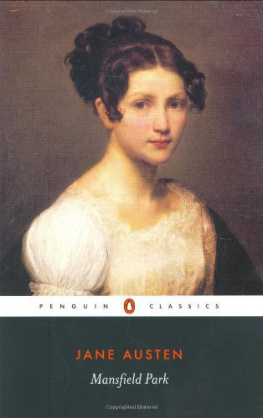Table of Contents
From the Pages of Fairy Tales

You see, ladies and gentlemen, Your Royal Majesty! You can never know what to expect from the real nightingale, but everything is determined in the artificial bird. It will be so-and-so, and no different! You can explain it; you can open it up and show the human thoughthow the cylinders are placed, how they work, and how one follows the other!
(from The Nightingale, page 10)
Its an old innate law and privilege that when the moon is in the precise position it was last night, and the wind blows as it blew yesterday, then all will-o-the-wisps born at that hour and minute can become human beings.
(from The Will-o-the-Wisps Are in Town, page 37)
This is certainly an interesting tinderbox if it will give me what I want like this!
(from The Tinderbox, page 90)
I almost didnt close my eyes the whole night! God knows what could have been in the bed? I was lying on something hard, so I am completely black and blue all over my body. Its quite dreadful!
(from The Princess on the Pea, page 107)
Way out at sea the water is as blue as the petals on the loveliest corn-flower, and as clear as the purest glass, but its very deep, deeper than any anchor rope can reach. Many church steeples would have to be placed end to end to reach from the bottom up to the surface and beyond. Down there the sea people live.
(from The Little Mermaid, page 188)
The emperor came to them with his most distinguished cavaliers. Both swindlers lifted one arm in the air as if they were holding something and said, See, here are the pants. Heres the jacket, and heres the cape! They continued on and on. They are as light as cobwebs. You might think you werent wearing anything, but thats the beauty of this fabric.
(from The Emperors New Clothes, page 215)
In the middle of a garden there was a rose tree that was completely full of roses, and in one of these, the most beautiful of them all, lived an elf. He was so tiny that no human eye could see him. He had a bedroom behind every rose petal. He was as well formed and lovely as any child could be and had wings from his shoulders all the way down to his feet. What a lovely fragrance there was in his rooms, and how clear and lovely the walls were! Of course they were the fine, pink rose petals.
(from The Rose Elf, page 289)
Dance she did and dance she must, dance in the dark night. The shoes carried her away over thorns and stubble that scratched her until she bled. She danced over the heath until she came to a lonely little cottage. She knew that the executioner lived there....
(from The Red Shoes, page 395)
The poor duckling who had been last out of the egg and who looked so dreadful was bitten, pushed, and made fun of, both by the ducks and the chickens. Hes too big, they all said, and the turkey rooster, who was born with spurs and thought he was an emperor, blew himself up like a clipper ship under full sail, went right up to him, gobbled at him, and turned red in the face. The poor duckling didnt know whether he was coming or going, and was very sad because he was so ugly. Indeed, he was the laughing stock of the entire hen yard.
(from The Ugly Duckling, pages 485-486)
Once upon a time there was a darning needle that was so refined and stuck-up that she was under the illusion that she was a sewing needle.
(from The Darning Needle, page 555)
Everything was once again where it was before except for the two old portraits of the peddler and the goose girl. They had been blown up to the wall in the great hall, and when someone who was an art expert said that they were painted by a master, they were repaired and remained hanging there. No one knew before that they were any good, and how would you know that? Now they hung in a place of honor. Everything in its proper place and eventually thats where everything ends up. Eternity is longlonger than this story.
(from Everything in Its Proper Place, page 597)


Published by Barnes & Noble Books
122 Fifth Avenue
New York, NY 10011
www.barnesandnoble.com/classics
Hans Christian Andersen published his first collection of fairy tales in 1835,
and continued to issue subsequent volumes until 1872, three years before
his death. Marte Hvam Hults new translation is based on the first
five volumes of H. C. Andersens Eventyr ( 1963-1967) .
Published in 2007 by Barnes & Noble Classics with new Introduction,
Notes, Biography, Chronology, Inspired By, Comments & Questions,
and For Further Reading.
Introduction, Commentaries on the Tales, and For Further Reading
Copyright 2007 by Jack Zipes.
Note on Hans Christian Andersen, The World of Hans Christian Andersen
and his Fairy Tales, Textual Annotations, Inspired by Andersens Fairy Tales,
Comments & Questions, and Marte Hvam Hults Original
Translation of Andersens Fairy Tales
Copyright 2007 by Barnes & Noble, Inc.
All rights reserved. No part of this publication may be reproduced or
transmitted in any form or by any means, electronic or mechanical, including
photocopy, recording, or any information storage and retrieval system, without
the prior written permission of the publisher.
Barnes & Noble Classics and the Barnes & Noble Classics
colophon are trademarks of Barnes & Noble, Inc.
Fairy Tales
ISBN-13: 978-1-59308-260-4 ISBN-10: 1-59308-260-6
eISBN : 978-1-411-43216-1
LC Control Number 2006925199
Produced and published in conjunction with:
Fine Creative Media, Inc.
322 Eighth Avenue
New York, NY 10001
Michael J. Fine, President and Publisher
Printed in the United States of America
QM
1 3 5 7 9 10 8 6 4 2
Hans Christian Andersen

The future author of the classic stories The Ugly Duckling, The Little Mermaid, and The Red Shoes, Hans Christian Andersen was born on April 2, 1805, into humble circumstances in the Danish city of Odense. His father, Hans Andersen, was an impoverished cobbler who had taught himself to read and write; his mother, illiterate and superstitious, worked as a washerwoman and died an alcoholic. From an early age, Hans shared his fathers love of the theater. When Hans was a boy, he and his father built a puppet theater, where Hans would enact dramas of his own invention. Desperate for money, in 1812 Hans Andersen Sr. was paid to take another mans place in the army of Denmark, allied with the French in the Napoleonic Wars. When he returned home, he was sick and suffering from an illness that would prove fatal in 1816. Before his mother remarried, young Hans worked in a factory, but the familys economic woes continued.
In 1819 Hansfourteen years old and with little education, but endowed with a remarkable singing voice and a gift for performanceleft Odense to seek his fortune in Copenhagen as a singer, dancer, or actor. Through his talents and ambition, as well as a certain audacity, he attracted wealthy patrons who arranged singing lessons and a small stipend for him. In 1820 he joined the choir of the Royal Theater, one of whose directors, Jonas Collin, had Hans sent to a private school in Slagelse, 50 miles from Copenhagen. When he returned to the city in 1827, he maintained his relationship with Collin, became a frequent dinner guest at the homes of the citys elite, and blossomed as a writer. His first poem, The Dying Child, appeared in 1827, and two years later he published a travel sketch in the style of German Romantic writer E. T. A. Hoffmann, who had a great influence on him.
Next page
